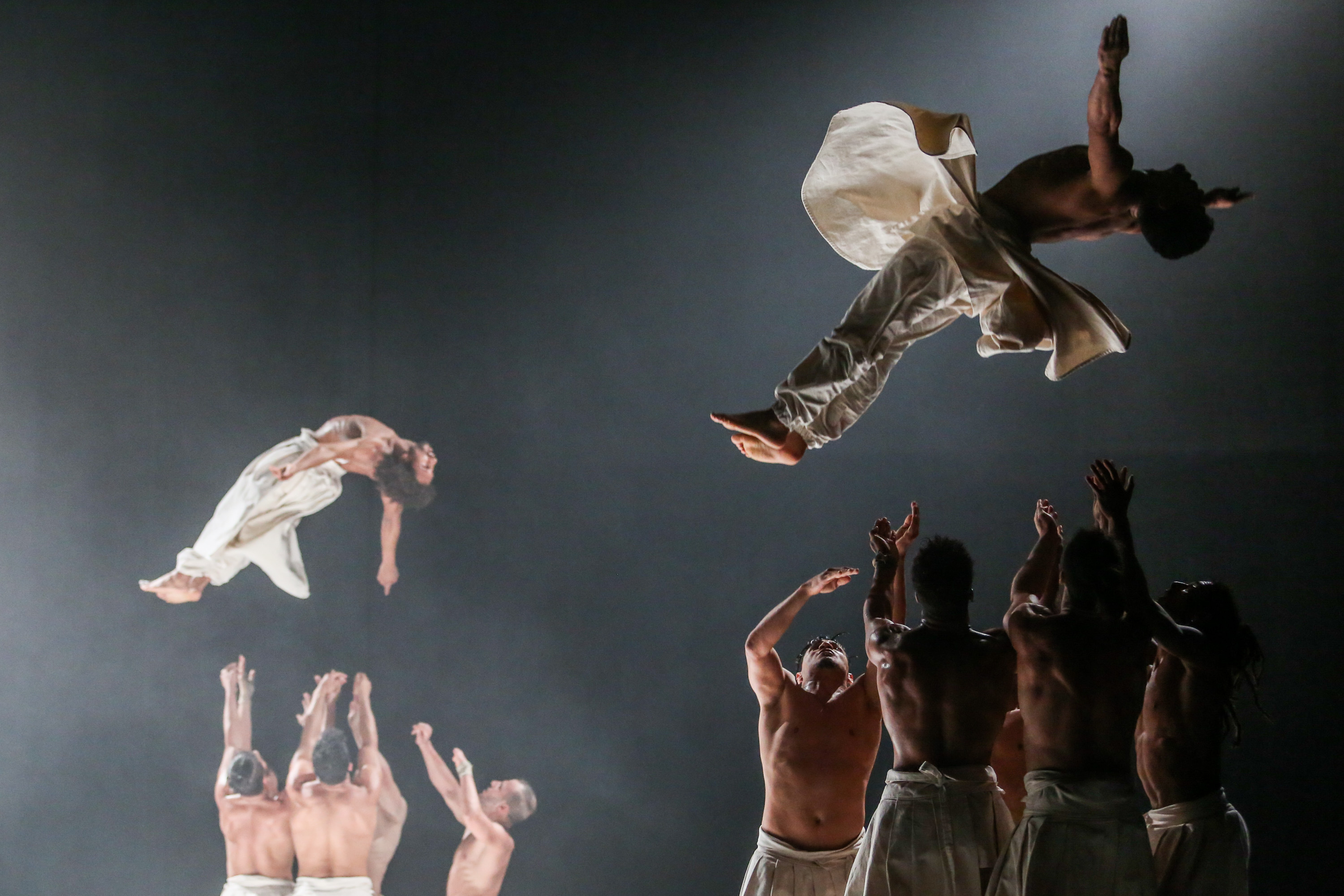
"If North African men preserved a traditional form of dance, they would perform it bare-chested, wearing loincloths over white leggings. They would whirl like dervishes then pause, slowly gesturing like desert mystics, beckoning through a bright haze. They would be strong, but wiry. They would mystify audiences, who would stare dumbfounded at the dual display of gymnastics and grace unlike anything in Western dance.
If North African men preserved a traditional form of dance, they would look a lot like Compagnie Hervé Koubi, the French-based, Algerian-rooted-troupe. Ce que le jour doit à la nuit is a stunning fusion of acrobatics, gymnastics, b-boying, modern dance and ballet. Add traditional Sufi music, haze and atmospheric lighting, and what Koubi has created looks deceptively like an ancient desert ritual.
Frenzied sections of movement, which included 15-foot trust falls and two men spinning on their heads, were followed by more deliberate ensemble sections. Unison breathing was part of the soundtrack. The men would stand, backs facing the audience, and let their rippling shoulders put on a show.
Even in the tumbling passes, the men exhibited an uncanny control."
Extracts of Washington Post Dance Review
"Compagnie Hervé Koubi has outstanding U.S. Debut"
Rebecca Ritzel
April 14, 2013

Of Algerian roots, Hervé Koubi grew up in the South of France where he studied both biology and dance at the University of Aix-en-Provence before graduating as a Pharmaceutical Doctor in 2002.
After deciding to concentrate on a dancing career and graduating from the world-renowned Rosella Hightower School of Dance in Cannes, Koubi gained professional experience as a dancer with the Opera de Marseille as well as with Jean-Charles Gil and Jean-Christophe Paré, respectively former principal dancers with the National Ballet de Marseille and the Paris Opera Ballet, on the development of new contemporary dance projects.
In 2000, Hervé Koubi created his first personal project Le Golem. Since 2001 he has collaborated with Guillaume Gabriel for all his creations. He created Menagerie and Les abattoirs, fantaisie… In 2006 he worked with musical artist Laetitia Sherrif for the creation of 4′30. In 2007, he reworked a piece created in 1997 on the Promenade de la Croisette in Cannes, Les Heures Florissantes (The Flowering Hours), for the Festival Cadence in Arcachon, as well as creating the contemporary and unusual work Moon Dogs — a Discovery of the movements of Hip-Hop. In 2008, he created three works based on three written works: Coppelia, une fiancée aux yeux d’email, The Supremes and Bref séjour chez les vivants. He collaborated with writer Chantal Thomas for the creation of The Supremes, and with Roman Panassié for the creation of Bref séjour chez les vivants. In 2009, he initiated a collaboration with Ivorian dancers from from the Beliga Kopé Company for the creation of Un rendez- vous en Afrique.
Since 2010, he has been working with a group of 12 dancers from Algeria and Burkina Faso for several productions: El Din (2010-2011), What the day owes to the night (2013), Le rêve de Léa (2014), Des hommes qui dansent (2014), Les nuits barbares ou les premiers matins du monde (2015-2016).
He also collaborated with videographers on their video dance projects: Max Vadukul for Yoji Yamamato’s Chic Chef, Pierre Magnol for Body Concrete, and Ovoid Edges, Pierre Magnol et Michel Guimbard for Body Concrete 2.
He is Associate Choreographer at the Pole National Supérieur de Danse since 2014 and at the Conservatoire de Danse de Brive-la-Gaillarde since 2015. In July 2015, choreographer Hervé Koubi was awarded the French medal of Chevalier des Arts et des Lettres.
In 2009, Hervé Koubi organised an audition in Algeria for the debut of a work which has now finished with the creation of Ce que le jour doit à la nuit. As the young boy, an ordinary hero from the eponymous novel by Yasmina Khadra, sent from one family to another, Hervé Koubi embarks as an explorer of his own history which crosses that of the boy’s with a big H. “It is like an orientalist of the 19th century come to Algeria to give life to his dreams of the Orient; I would like to give life to my dreams as a child born in France, and who discovered belatedly his true origins and those of his parents, Algerians from birth.”
Twelve Algerian and Burkina Faso dancers, mostly coming from street dance, from hip-hop, have furnished the necessary effort for this long-term project, encountered and then worked with each of the interpreters, already attempted with El Din. Fed by Orientalist paintings, the stone filigree of Islamic architecture, Hervé Koubi traces his own path, made of entanglements, a complex weave. Ce que le jour doit à la nuit is as its title implies, a mixing up of time and a story of links.

Cast
Badr BENR GUIBI
Giacomo BUFFONI
Mohammed ELHILALI
Youssef EL KANFOUDI
Abdelghani FERRADJI
Vladimir GRUEV
Oualid GUENNOUN
Bendehiba MAAMAR
Nadjib MEHERHERA
Houssni MIJEM
Ismail OUBBAJADDI
El Houssaini ZAHID
Music :
Maxime Bodson, Hamza El Din - Kronos Quartet, Jean-Sébastien Bach, Soufi
Lights :
Lionel Buzonie
Costumes :
Guillaume Gabriel
Coproductions :
Ballet of the National Opera of Rhin - National Choreographic Center / National Choreographic Center of Creteil et du Val de Marne - Company Kafig / Palace of the Congress de Loudéac / Cultural Center of Vitré / Ballet Preljocal - National Choreographic Center of Aix en Provence / Ballet Biarritz - Thierry Malandain - National Choreographic Center
BCMO Pole chorégraphique de Calais / Ville de Calais – Grand Calais terres et mers


